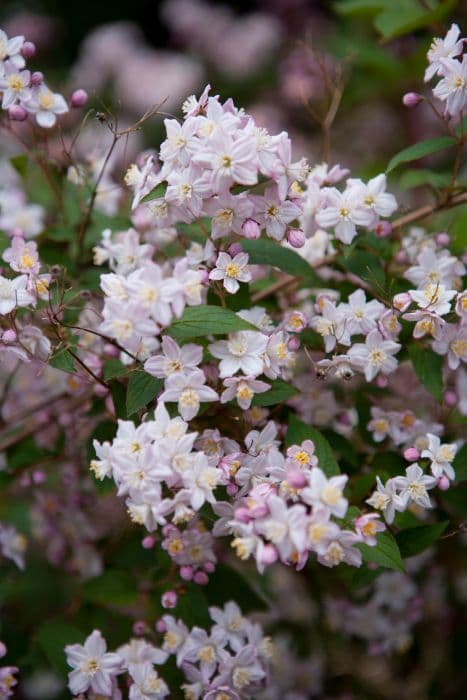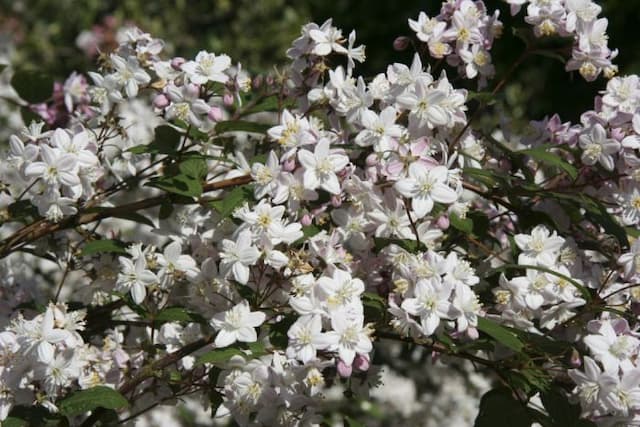Yellow Wax Bells Kirengeshoma palmata Koreana Group

ABOUT
Kirengeshoma palmata Koreana Group, commonly known as yellow wax bells, is a plant that boasts a distinctive and attractive appearance. This shade-loving perennial features large, maple-like leaves that are deeply lobed and have a soft texture, creating an appealing backdrop for its unique flowers. The foliage tends to have a lush, dark green coloration, adding a rich visual texture to garden spaces. In late summer to early autumn, the plant produces pendulous, bell-shaped flowers. These blooms are a soft yellow hue and dangle elegantly from arching stems, nodding gracefully in the breeze. The contrast between the delicate flowers and the bold foliage makes the yellow wax bells a stand-out specimen in the garden, providing a touch of elegance and visual interest during a season when many other plants are beginning to fade. The overall appearance is one of serene beauty that can add a tranquil ambiance to any shaded garden setting.
About this plant
 Names
NamesFamily
Hydrangeaceae.
Synonyms
Yellow Wax Bells, Korean Yellow Wax Bells.
Common names
Kirengeshoma palmata Koreana Group.
 Toxicity
ToxicityTo humans
Yellow wax bells is not commonly known to be toxic to humans. There are no well-documented cases of poisoning from this plant, and it is generally not associated with any significant toxicity. As with any plant, individuals may have allergic reactions, or it could cause mild stomach upset if ingested in large quantities, but there are no specific symptoms of poisoning associated with yellow wax bells due to its lack of toxicity.
To pets
Yellow wax bells is not commonly known to be toxic to pets, including cats and dogs. It is not listed on common toxic plant databases, and there are no well-documented cases of pet poisoning from ingestion of this plant. However, as with any non-food plant, ingestion can potentially lead to gastrointestinal upset, such as vomiting or diarrhea, if eaten in large quantities. Pets should still be discouraged from eating ornamental plants as a general precaution.
 Characteristics
CharacteristicsLife cycle
Perennials
Foliage type
Deciduous
Color of leaves
Green
Flower color
Yellow
Height
3-4 feet (0.9-1.2 meters)
Spread
3 feet (0.9 meters)
Plant type
Herb
Hardiness zones
5
Native area
Korea
Benefits
 General Benefits
General Benefits- Ornamental Value: Kirengeshoma palmata Koreana Group is appreciated for its unique, nodding yellow flowers and palmate leaves, adding aesthetic beauty to shade gardens.
- Pollinator Attraction: The flowers can attract bees and other pollinators, contributing to the local ecosystem's biodiversity.
- Shade Tolerance: This plant thrives in shaded areas where many other flowering plants struggle, providing landscaping options in darker parts of a garden.
- Seasonal Interest: It blooms in late summer to early fall, a time when many other plants have finished flowering, thus extending the garden's display season.
- Low Maintenance: Once established, it requires minimal upkeep, which can save time and gardening resources.
- Deer Resistance: The plant is known to be less palatable to deer, reducing the risk of damage in areas with deer populations.
 Medical Properties
Medical PropertiesThis plant is not used for medical purposes.
 Air-purifying Qualities
Air-purifying QualitiesThis plant is not specifically known for air purifying qualities.
 Other Uses
Other Uses- Kirengeshoma palmata Koreana Group, commonly known as yellow wax bells, can be used as a natural dye source, providing a range of yellow to green hues depending on the mordant used.
- The large, maple-like leaves of yellow wax bells can be used in floral arrangements to provide a lush, green backdrop for other flowers.
- In educational settings, this plant can be used to teach about pollination and the role of bumblebees, which are commonly attracted to its flowers.
- Yellow wax bells can be planted in shaded rock gardens to add texture and contrast with its bold foliage and unique flower shape.
- This plant can be used in art classes for botanical drawing due to its distinctive leaf and flower structure that challenges the artist's skills.
- Yellow wax bells can be utilized as background plants in photography to create a serene, all-green setting or a contrast for colorful subjects.
- They are suitable for a woodland garden setting where they can enhance the naturalistic aesthetic of the landscape with their informal growth habit and delicate blossoms.
- The seed pods of yellow wax bells can be used in dried flower arrangements, adding interest with their unusual shape and texture.
- For gardeners interested in autumn aesthetics, yellow wax bells provide late summer to early fall blossoming when many other plants have finished flowering.
- As a relatively rare plant in cultivation, yellow wax bells can be used to create a sense of exclusivity and uniqueness in a collector's garden.
Interesting Facts
 Feng Shui
Feng ShuiThe Yellow wax bells is not used in Feng Shui practice.
 Zodiac Sign Compitability
Zodiac Sign CompitabilityThe Yellow wax bells is not used in astrology practice.
 Plant Symbolism
Plant Symbolism- Uniqueness: Kirengeshoma palmata Koreana Group, commonly known as Yellow Wax Bells, has distinctive, nodding yellow flowers that set it apart from other woodland plants, symbolizing uniqueness or standing out from the crowd.
- Elegance: The elegant, palmate leaves and the way the flowers delicately hang lend the plant a refined look, hence it is often associated with grace and elegance.
- End of Summer: As the Yellow Wax Bells bloom in the late summer, they are a symbol of the transition from summer to autumn, representing change or the passing of time.
- Rarity: Given that the plant is not as common in gardens compared to others, its presence can symbolize rarity or a treasure to be sought after.
 Water
WaterThe Yellow Wax Bells should be watered regularly to keep the soil consistently moist but not waterlogged. During the growing season, you may need to water once or twice a week depending on weather conditions. A general rule is to provide the plant with about 1-2 gallons of water weekly, making adjustments based on rainfall and temperature. It’s important to water the plant at the base, avoiding wetting the foliage, to prevent fungal diseases. During winter, reduce watering as the plant goes dormant, but do not allow the soil to completely dry out.
 Light
LightThe Yellow Wax Bells thrives best in partial shade, avoiding the intense midday sun which could scorch the foliage. A spot that receives morning sun and afternoon shade or dappled sunlight throughout the day is ideal. Ensuring that the plant is shielded from strong, direct sunlight will promote healthy growth and flowering.
 Temperature
TemperatureThe Yellow Wax Bells prefers a temperate climate and performs well in temperatures ranging from 45°F to 75°F. While it can survive minimum temperatures down to about 30°F, frost and freezing conditions can damage the plant. Ideally, maintain ambient temperatures within the preferred range and protect the plant from harsh winter chills for optimal health and growth.
 Pruning
PruningPruning of the Yellow Wax Bells is minimal and mainly involves removing any spent flowers or dead foliage to maintain tidiness and encourage more blooms. Ideally, pruning should be done after flowering. Light pruning or deadheading can be performed during the growing season to keep the plant looking its best.
 Cleaning
CleaningAs needed
 Soil
SoilYellow wax bells prefer a fertile, humus-rich, well-drained soil mix with a slightly acidic to neutral pH, generally between 5.5 and 7.0. A blend of loamy garden soil, peat or leaf mold, and perlite or sand to promote drainage would be ideal for ensuring the plant’s health and vigorous growth.
 Repotting
RepottingYellow wax bells typically do not need to be repotted frequently. They can be left undisturbed for several years unless they have outgrown their current container. Repotting every 3-5 years should suffice, during which one can refresh the soil and divide if necessary for propagation.
 Humidity & Misting
Humidity & MistingYellow wax bells flourish in moderate to high humidity levels. To achieve their optimal growth, maintaining the surrounding humidity around 50-60% is beneficial. They will thrive best when the air is not too dry, especially indoors.
 Suitable locations
Suitable locationsIndoor
Keep Yellow wax bells in moist soil and indirect light.
Outdoor
Plant in partial shade, moist, well-drained soil.
Hardiness zone
5-8 USDA
 Life cycle
Life cycleThe life cycle of the Kirengeshoma palmata Koreana Group, commonly known as Korean yellow wax bells, begins with seed germination in spring, where the plant emerges from dormancy and starts to grow from the dispersed seeds. During the spring and early summer, leafy stems develop and the foliage expands to form an attractive, shade-tolerant mound. By late summer to early autumn, the plant produces distinctive, nodding, bell-shaped yellow flowers that are slightly waxy in texture. Following flowering, pollination occurs, typically by insects attracted to the flowers' nectar, leading to the formation of seed capsules that contain the seeds for the next generation. Throughout autumn, the plant's foliage starts to die back as it enters a period of dormancy throughout the winter months, conserving energy in its rhizomes. The cycle starts anew the following spring when temperatures rise and new growth can emerge from the rhizomes.
 Propogation
PropogationPropogation time
Late winter to early spring
Propogation: The most popular method for propagating Kirengeshoma palmata Koreana Group, commonly known as Yellow Wax Bells, is by division. Division should ideally be done in the spring as the new growth appears. The clump of the plant should be carefully lifted from the ground, making sure not to damage the roots any more than necessary. Using a sharp spade or knife, the clump can then be divided into smaller sections, each with several shoots and a portion of the root system. These sections are immediately replanted at the same depth they were growing at before and watered thoroughly. This encourages the development of a strong root system in their new location. Care should be taken to keep the soil moist but not waterlogged to avoid root rot while the new divisions establish themselves.







![Hydrangea [Early Sensation]](/_next/image?url=https%3A%2F%2Fplants-admin.emdemapps.com%2Fimages%2Fplants%2F%2Fimages%2F604b6150338db.png&w=640&q=75)

